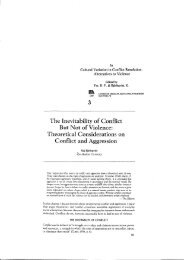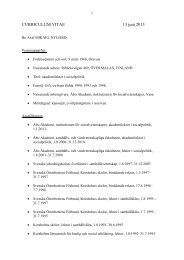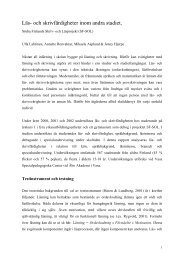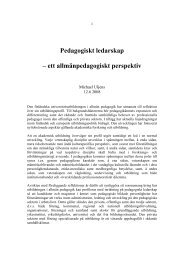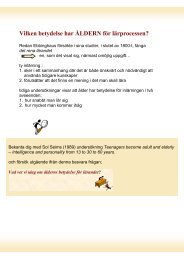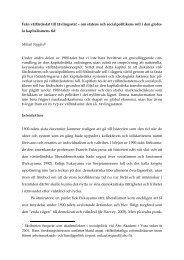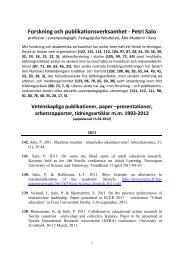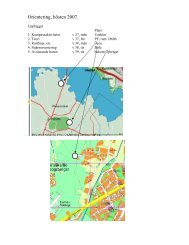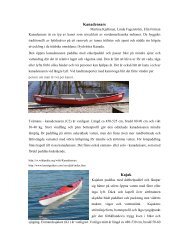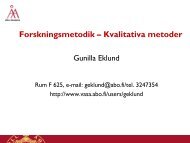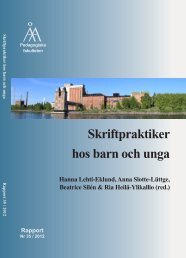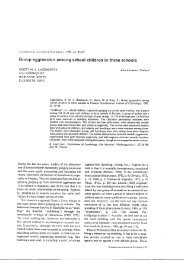Parties, Candidates and Citizens On-Line - Åbo Akademi
Parties, Candidates and Citizens On-Line - Åbo Akademi
Parties, Candidates and Citizens On-Line - Åbo Akademi
Create successful ePaper yourself
Turn your PDF publications into a flip-book with our unique Google optimized e-Paper software.
(cf. Strom 1990, 570), <strong>and</strong> consequently, the findings are quite difficult to interpret. Even<br />
though all three Finnish parties competing for the main part of all votes in modern<br />
Finnish elections (cf. Moring 2003; Nousiainen 1998, 49), i.e. the SDP, Centre <strong>and</strong> NCP,<br />
are contained within cluster I, the parties in cluster I are quite varied in terms of their<br />
other party goals. The major parties also have an office-seeking agenda (Sundberg 1996,<br />
16). The SPP is often included in the Finnish governmental cartel but is also a policy<br />
advocating minority party (Nousiainen 1998, 34-35; Sundberg 1996, 16). The Greens <strong>and</strong><br />
the LWA both emphasize goals on the internal arena (Nousiainen 1998, 78, 89; Zilliacus<br />
2001, 50-51). Again, concerning the parties in cluster II, there is little scholarly knowledge<br />
of their general goals. Tentatively though, the agendas of these parties appear very<br />
different, ranging from policy-advocating parties (Alternative People, Union of free<br />
Finl<strong>and</strong>; For the Poor, Finnish People’s Blue-whites) to parties focusing more on the<br />
internal arena (CPF <strong>and</strong> CWP).<br />
In sum, relating to the two party clusters found concerning the contents of the<br />
Finnish parties’ websites, party size <strong>and</strong> resources seems to be related to higher index<br />
scores. Again, as for the cluster found from the party questionnaire, certain specific party<br />
website scores also seem explainable in light of other theoretical circumstances – such as<br />
the Green League scoring relatively highly on participation <strong>and</strong> the CPF emphasizing<br />
internal communication – but, in general, party size seems to have the most evident<br />
influence on the Finnish parties’ website contents.<br />
Summary of descriptive findings<br />
The findings concerning the descriptive research questions are summarized in this<br />
section. The study’s main explorative questions are therafter examined in the concluding<br />
section.<br />
Regarding the first descriptive research question – what are the Finnish parties’<br />
opinions concerning the importance <strong>and</strong> use of their website? – some of the findings<br />
merit attention here. Firstly, in general, the Finnish parties do not appear to have a high<br />
degree of central planning of their websites, nor employ large amounts of internal or<br />
external personnel in maintaining the sites. Many parties stated that the local branches<br />
were responsible for several sections of their websites <strong>and</strong> that the people working with<br />
their website have other more important responsibilities. Secondly, the Finnish parties<br />
nonetheless perceive their website to be an important communication tool compared to<br />
traditional communication channels. Surprisingly, though, some fringe parties ranked the<br />
website lower than traditional communication channels (cf. Gibson et al. 2003b, 102).<br />
The Finnish parties’ general opinion of political websites was also positive. Most of the<br />
party information officials felt that there are more advantages than drawbacks with having<br />
102



